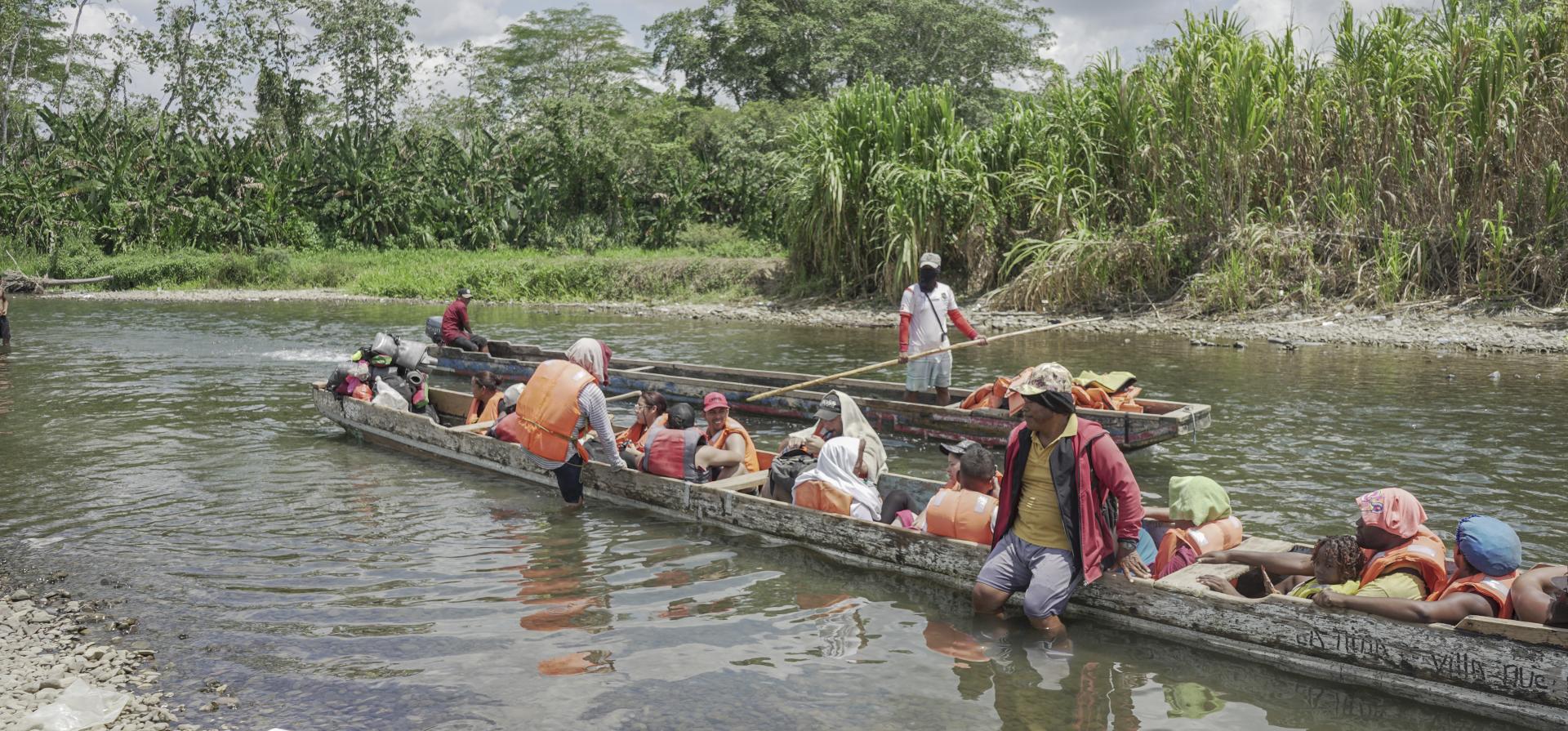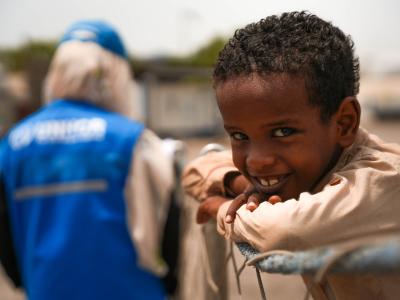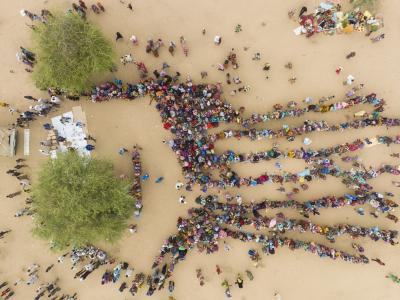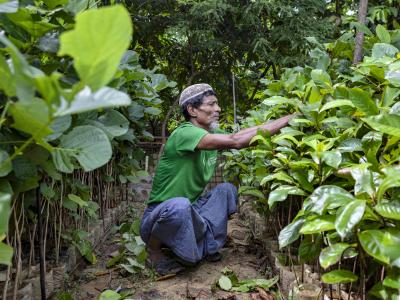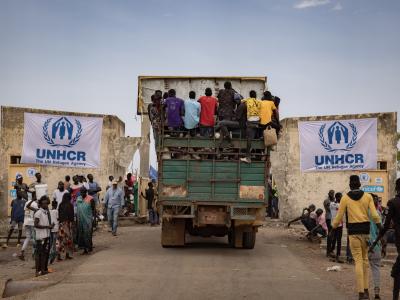Regional overview
The Americas hosted 23 million forcibly displaced people and others in need of UNHCR’s protection and assistance in 2023, an increase of one million and a half from 2022, driven by displacement situations in Colombia, the Bolivarian Republic of Venezuela, Haiti, northern Central America, Mexico and Nicaragua. An unprecedented 520,000 people from more than 35 countries crossed the Darien jungle in Panama to move from South to North America, more than the total who made that perilous journey in the previous 12 years, and double the 2022 number. UNHCR invested in platforms such as Trust the Jaguar, Trust the Toucan, and Somos Panas to give people reliable information about the risks of crossing the Darien and to combat misinformation. UNHCR and IOM jointly called for a collaborative response to the movement of refugees and migrants, and worked with their partners to provide humanitarian assistance and assist those in need of international protection with their application for refugee status. With a record number of arrivals at the U.S. southern border, UNHCR welcomed U.S. initiatives to expand safe and legal pathways and urged the Government not to impose barriers to asylum. UNHCR worked with partners on both sides of the border to provide shelter and humanitarian assistance, and legal assistance for asylum-seekers, preventing the separation of families, and providing technical advice to government authorities on how to develop fair and efficient asylum systems that respect international refugee law.
Venezuelans continued leaving their country in greater numbers than those returning. Host governments made commendable efforts to meet their need for regular residency status. Brazil recognized over 123,000 Venezuelans as refugees and granted temporary residency permits to over 411,000. Colombia, with close to 2.5 million biometrically registered Venezuelans, issued temporary protection permits to 1.6 million. Ecuador registered 259,000 Venezuelans through an ongoing regularization mechanism, while Peru granted temporary stay to over 200,000 through a newly launched programme. The United States of America expanded its parole process, admitting more than 55,000 Venezuelans in the first nine months of 2023, and Chile implemented a biometric registration process, identifying 130,000 individuals, primarily Venezuelans, in need of regular stay.
Colombia continued to grapple with multiple displacement situations, hosting 2.9 million Venezuelans and over half a million Colombians returning from Venezuela. Colombia had the largest number of internally displaced people (IDPs) in the world, at 6.9 million by year-end. UNHCR worked with the Government on the protection of IDPs, and building on the Total Peace Agenda, supporting conflict-affected communities, returns, relocations, and the legalization of urban settlements with a high number of IDPs. In Colombia, El Salvador, Haiti, Honduras and Mexico, UNHCR strengthened national responses for IDPs, helping to ensure they could access public services, legal support and humanitarian assistance.
Canada, Mexico, and the United States of America were among the top 10 recipients of new asylum applications worldwide, with many applications from the Bolivarian Republic of Venezuela, Cuba, Colombia, Haiti and Nicaragua. Under the Comprehensive Regional Protection and Solutions Framework (MIRPS), governments adopted a holistic approach to the different stages of displacement and to assistance in countries of origin, host communities, transit countries and destinations. UNHCR supported Mexico’s efforts to keep pace with the huge number of asylum claims, quadrupling processing capacity since 2018, as well as helping to receive, shelter and register new arrivals. A UNHCR programme also helped refugees relocate from southern border areas to cities in central and northern Mexico where jobs are more plentiful, and children have a better chance of a normal, dignified life. Over 600 private companies worked with UNHCR, hiring refugees. Tens of thousands of Venezuelans were also able to find work in Brazil and Colombia, while in Honduras, UNHCR launched an internship financing project to bring young displaced people into the labour market. Labour programmes were supported by UNHCR’s engagement with development and financial actors and the private sector, which expanded financing for host countries, through loans and non-reimbursable grants.
UNHCR significantly increased the region’s capacity to resettle refugees and in coordination with IOM, supported the Safe Mobility Initiative (SMO) in Colombia, Costa Rica, Guatemala and Ecuador to expand access to resettlement and other pathways to the United States of America, Canada and Spain. Almost 25,000 individuals were submitted for resettlement in 2023, including close to 14,000 as part of the SMO initiative.
Countries of the Caribbean region, mainly through the Caribbean Community (CARICOM), responded to forced displacement from Haiti, with UNHCR advocating against the forced return of Haitians and supporting national asylum systems. Increased gang violence in Haiti raised significant protection concerns, prompting UNHCR's efforts to strengthen local protection systems.
UNHCR promoted comprehensive and coordinated regional responses that address displacement and support sustainable solutions, such as R4V, MIRPS, the Quito Process, and Cities of Solidarity. UNHCR also sought to make responses local, especially via the meaningful participation of forcibly displaced women and women-led organizations. UNHCR also strengthened collaborations to improve gender equality, sexual and reproductive health, and interventions for young people. During the 2023 Global Refugee Forum, Latin American and Caribbean countries launched the Cartagena+40 process to create a regional roadmap addressing protection and solutions, emphasizing priorities like human mobility, development, and disaster displacement.
Regional expenditure and budget
$355 million spent against a budget of $827 million
$472 million of unmet needs or 57% of the budget
Population overview
Financial overview
Trends in response
Multisectoral monitoring results
Protection

Child protection

Accountability to
affected populations

Basic needs


Shelter

Health



1.8 million people received protection services*
2022 result: 1.6 million
*Protection services encompasses a vast range of community-based, individual and household interventions in various domains of UNHCR protection work, including counselling and information on rights, sensitization on protection issues, community outreach and mobilization, specialized services for children or other persons with specific needs, GBV programming, legal assistance, registration and documentation, Refugee status determination and resettlement case-work, protection monitoring.
583,000 children received protection services*
2022 result: 471,000
67% of countries in the region had child protection services available to forcibly displaced and stateless children
*Child protection services include support through Best Interests Procedures for children at risk, targeted support for children with specific needs and children in alternative care, support through family tracing and reunification, and reintegration support for children associated with armed groups and forces.
87% of reporting countries had a multi-channel feedback and response system that was designed based on consultations with forcibly displaced and stateless people
2022 result: 86%
124,500 people received cash assistance
2022 result: 193,600
453,000 people received non-food items including core relief items*
Indicator not available in 2022
*This indicator reflects the total number of people who benefited from the direct distribution of in-kind non-food items, including domestic Core Relief Items (CRIs) and excluding shelter CRIs.
243,000 people received shelter and housing assistance*
Indicator not available in 2022
*Shelter and housing assistance includes emergency, transitional and durable shelter provision, collective shelter, shelter repair and maintenance, and rental programming.
127,000 people received essential health care services
2022 result: 187,200
20,000 women and girls received sexual and reproductive health services*
2022 result: 40,400
*Sexual and reproductive health services include antenatal care, assisted delivery, postnatal care, family planning services and health services for survivors of gender-based violence.
92,000 people received mental health and psychosocial support services
2022 result: 91,500
Situations
El Salvador, Guatemala and Honduras situation
Operations*
Argentina Multi-Country Office | Brazil | Colombia | Costa Rica | Ecuador | El Salvador | Guatemala | Honduras | Mexico | Peru
*The operations listed above are the ones with annual results reports available on Global Focus for 2023.
